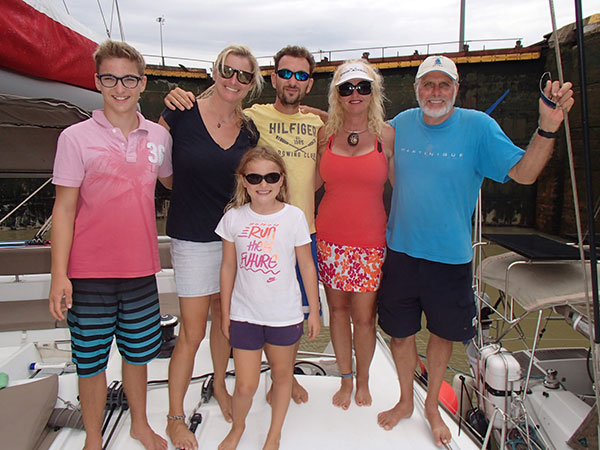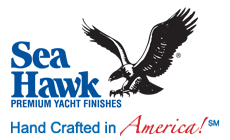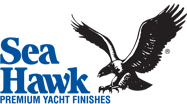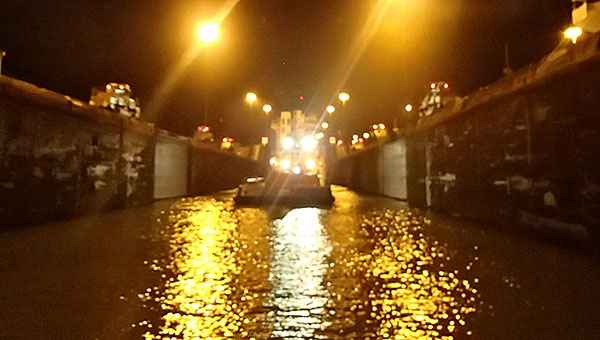A “FRENCH CONNECTION” PANAMA CANAL TRANSIT

Contact Sea Hawk
14805 49th Street NorthClearwater, FL 33762
(727) 523-8053
(800) 528-0997
(727) 523-7325
contact@seahawkpaints.com
A "FRENCH CONNECTION" PANAMA CANAL TRANSIT
February 19, 2016by Bill and JoAnne Harris
Our French friends Virginie and Nicolas invited us to join them aboard S/V Phileas, their Lagoon 45 catamaran, for almost two weeks for what would be one of the most memorable times of our lives. Of course we said, “Yes!” This was a fantastic opportunity. Our Panama Canal adventure began in Bocas del Toro, Panama, where we left our trimaran, Ultra, at Bocas Marina & Yacht Club and hopped on a water taxi to the mainland town of Almirante. From there, we boarded a double-decker bus to the city of David. We stayed there one night (to check the status of Ultra’s Perkins engine rebuild at Grupo Vargas-Matamoros Repair Shop). The next morning, Bill’s birthday, we were on the early morning bus for the eight-hour ride to Panama City. It was an extremely comfortable trip, since our tickets were for the upstairs front-row seats: #1 and #2. These provided a great view and better comfort; we had been warned that the bottom level was known for its Arctic temperatures. From the bus stop, we took a taxi to make our French Connection with Phileas at Shelter Bay Marina. Virginie, Nicolas and their son, Oscar, and daughter, Athénaïs, were in the midst of preparing Phileas for the long passage to the South Pacific. We spent the next week aboard, assisting with the last-minute activities such as finding space for all of their provisioning, doing general boat projects, helping run last minute errands, and most of all savoring our time together. It will be over a year before we will visit them in French Polynesia.

Bill and JoAnne Harris (far right) with Virginie and Nicolas and their kids Oscar and Athénaïs
We were all excited about experiencing this spectacular Panama Canal adventure together! One of Bill’s family members helped to build the Panama Canal and he has a medallion that was issued to his relative by President Roosevelt. Several years ago, as a surprise for Bill and his son, David, JoAnne contacted the Panama Canal Society and received certificates and additional information regarding the medallion and the relative whose name is engraved upon it.
The Canal, which celebrated its hundredth birthday last year, is one of the Seven Wonders of the Modern World named by the American Society of Civil Engineers. It is 48 miles long, runs 24 hours a day, seven days a week, and over 14,000 vessels pass through it annually. While in the area, we witnessed the US$5.25 billion combined Panama-China canal expansion project and the installation of the eight new sets of gigantic lock gates that are 65 feet wide and seven feet thick, and range from 47 to 82 feet high, depending on their location. The heaviest weighs 662 tons. Currently, the word on the water is there are major issues with the gates: they do not close properly and are leaking.
The Panama Canal Transit
On the morning of March 29th, Nicolas gave us a captain’s orientation about what to expect when taking the yacht through the Canal. At around 1:00PM, we set out for the canal-transit staging anchorage area called The Flats, where Virginie prepared a fantastic French lunch. After lunch, we were contacted by the Panama Canal Advisor (each vessel is required to have a Transit Advisor appointed by the Panama Canal Authority to advise the captain during the passage) and were told that our transit would be delayed. We all decided to take a nap, so we would be wide awake and ready for the long night ahead. At 6:45PM the advisor arrived at Phileas, we hoisted the anchor and were underway for the first lock. At around 8:00PM we arrived at the first of the three Gatún Locks, which raise Pacific-bound vessels nearly 30 meters from the Caribbean to Lake Gatún. Forty five minutes later, Phileas was flanked with a monohull on each side (both participants in the Blue Planet Odyssey) and at 10:30PM we entered the locks. Nicolas is an excellent captain and navigated the locks like a pro. As crew, we made sure the monohull line handlers were doing their jobs well. Virginie served us all a deliciously fancy French dessert as we lounged on the decks during the smooth late-night passage.
Under the three-quarter moon and the bright golden lights of the Canal, we exited the Gatún Locks at 11:35PM. We disengaged Phileas from the two monohulls to allow us to tie up to one of the two gigantic mooring balls in the pristine fresh water of Lake Gatún. The monohulls arrived a little later, and rafted to each side of Phileas for the night. The Advisor, Francisco, did not spend the night aboard and had a water taxi take him to shore. At midnight, we all toasted with a glass of French red wine and headed to bed. It was a magical night, as the sounds of the creatures in the jungle filled the air. The next morning at 6:30AM, our new Advisor, Roy, arrived wearing a bright blue Captain America T-shirt for a great French breakfast. Fifteen minutes later we fired up the engines, untied from the mooring and the monohulls, and we were on the move again. We cruised at eight knots for approximately three hours through the breathtakingly beautiful Lake Gatún. It is a wildlife watchers’ paradise!
At 7:15AM, to our surprise, Roy stated we that had arrived three hours too early to enter the next locks, at Pedro Miguel, so we tied to one of two mooring buoys to wait our turn. Upon the approach to the final set of locks, Miraflores, once again the monohulls arrived and rafted up to Phileas, and at 2:00PM we entered them. At 3:50PM, we passed under the Bridge of the Americas and into the wide-open Pacific Ocean! Soon an old Navy motor launch, complete with diesel inboard and tiller steering, arrived to collect the four 70-foot dock lines and eight large ball fenders that are mandatory to pass through the Panama Canal. (You may supply your own or you can rent them.) At 5:00PM, we anchored outside of La Playita Marina. The dinghy fee is good for seven days, but was US$43 per person! And note: the seven-day period begins on a Monday and ends on a Sunday; if you show up on Sunday, you will be charged for a full week.
Panama City, Revisited
After wishing “bon voyage” to Phileas and before our return to Bocas del Toro, we took the bus to Panama City. This was JoAnne’s second visit, and Bill’s first; we wanted to explore the city together. Back in 1998 and ’99, a few years before the United States turned the Canal over to Panama, JoAnne visited Panama frequently while working for a Texas-based oil and gas company. While there, she was shown by her Panamanian counterparts all that Panama had to offer: the vibrant culture, the famous landmarks including the Panama Canal, and more. During our recent stay, we had the great opportunity to reunite with JoAnne’s Panamanian business contacts. It was quite an experience for them to give us a tour after all these years.
Our photos from 20 years ago are night and day!
Panama has undergone an unbelievable transformation, and is an incredibly modern city. It is full of beautiful high-rises, amazing architecture, and countless corporations. Furthermore, a chain of islands (Naos, Culebra, Perico and Flamenco) located near the Pacific entrance to the Canal that was used as a US military base is now accessible to everyone via the Amador Causeway. An extremely popular tourist playground, it is full of restaurants and hotels, plus the Biomuseo, La Playita Resort & Marina and the Flamenco Yacht Club & Marina, recently the venue for the second annual Panama Boat Show. Nearby is the Balboa Yacht Club, which has a limited number of moorings and slips available.
While in Panama City, you must stroll the walkway along Panama Bay and visit the newly restored buildings of Casco Viejo (the old city center and a UNESCO World Heritage Site), visit the fish market, and attend a traditional Panamanian costumed dance show while you sip the national cocktail, Chichita Panama, a combination of Seco Herrerano (liquor triple-distilled from sugarcane), grapefruit and pineapple juice, and honey. Also, be sure not to miss the unforgettable malls for endless shopping
opportunities.
Visit www.noonsite.com/Members/sue/R2012-03-14-3 for more information on transiting the Panama Canal.



